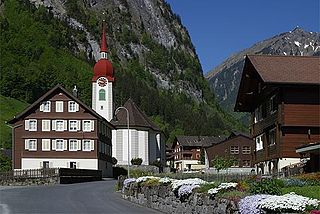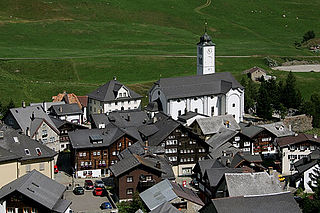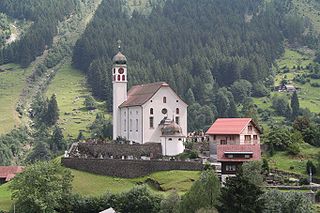
Göschenenlocally[ɡɔʊʃɛnɛn] is a village and municipality in the canton of Uri in Switzerland. It sits at the northern end of the Gotthard tunnel. The Göschenen riots (1875) saw Urner troops opening fire on Italian miners demonstrating for better working conditions and wages on the tunnel's construction site.

Isenthal is a municipality in the canton of Uri in Switzerland.

Attinghausen is a village and a municipality in the canton of Uri in Switzerland.

Bauen is a former municipality on Lake Lucerne in the Swiss canton of Uri. On 1 January 2021 the former municipality of Bauen merged into the municipality of Seedorf.

Bürglen is a municipality in the canton of Uri in Switzerland.

Bas-Intyamon is a municipality in the district of Gruyère in the canton of Fribourg in Switzerland. The villages of Enney, Estavannens and Villars-sous-Mont formed it.

Erstfeld is a municipality in the canton of Uri in Switzerland.

Gurtnellen is a village and a municipality in the canton of Uri in Switzerland.

Hospental is a municipality in the canton of Uri in Switzerland.

Realp is a municipality in the canton of Uri in Switzerland.

Schattdorf is a village and a municipality in the canton of Uri in Switzerland.

Seelisberg is a municipality in the canton of Uri in Switzerland.

Silenen is a municipality in the canton of Uri in Switzerland.

Spiringen is a village and a municipality in the canton of Uri in Switzerland. The municipality comprises two disjoint areas, separated by the municipality of Unterschächen and the Klausen Pass. The western area includes the village of Spiringen in the Schächen Valley, whilst the eastern area includes the Urner Boden alp above Linthal and the canton of Glarus.

Unterschächen is a municipality in the canton of Uri in Switzerland, situated in the upper Schächental.

Wassen is a municipality in the canton of Uri in Switzerland.

Geuensee is a municipality in the district of Sursee in the canton of Lucerne in Switzerland.

Vionnaz is a municipality in the district of Monthey in the canton of Valais in Switzerland.

Ferden is a municipality in the district of Raron in the canton of Valais in Switzerland. Besides the village of Ferden itself, the municipality includes the hamlet of Goppenstein, and the alpine settlements of Faldum, Resti and Kummen.

Kippel is a municipality in the district of Raron in the canton of Valais in Switzerland.

























